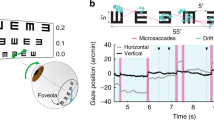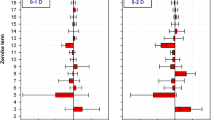Abstract
CLEAR evidence that the human retina stretches during accommodation was presented by Moses1, but his measurements were all made at the anterior margin of the retina, so they did not show how this stretch is spatially distributed. If it is largely confined to the region of the ora serrata, its contribution to the perceptual correlates of accommodation will be much less than if the central retina is distorted as well. A perceptual effect involving accommodation-dependent distortions in the visual field has recently been attributed by its discoverers2 to such a stretching of the central retina, although non-retinal explanations for this effect are also tenable.
Similar content being viewed by others
References
Moses, R. A., Adler's Physiology of the Eye, 5th ed., 357–360 (Mosby, St. Louis, 1970).
Blank, K., and Enoch, J. M., Science, 182, 393–395 (1973).
Fincham, E. F., J. Physiol., Lond., 128, 99–112 (1955).
Last, R. J., Wolff's Anatomy of the Eye and Orbit, 6th ed., 143 (Saunders, Philadelphia, 1968).
Heinemann, E. G., Tulving, E., and Nachmias, J., Am. J. Psychol., 72, 32–45 (1959).
Author information
Authors and Affiliations
Rights and permissions
About this article
Cite this article
HOLLINS, M. Does the central human retina stretch during accommodation?. Nature 251, 729–730 (1974). https://doi.org/10.1038/251729a0
Received:
Revised:
Issue Date:
DOI: https://doi.org/10.1038/251729a0
- Springer Nature Limited
This article is cited by
-
Curvy, shape-adaptive imagers based on printed optoelectronic pixels with a kirigami design
Nature Electronics (2021)





